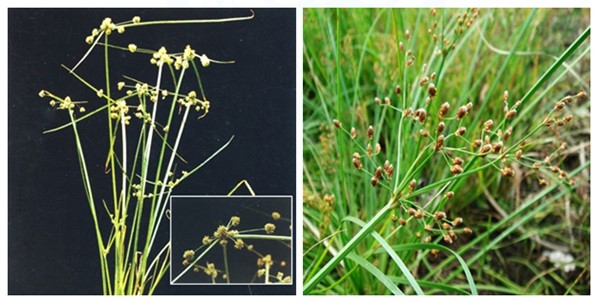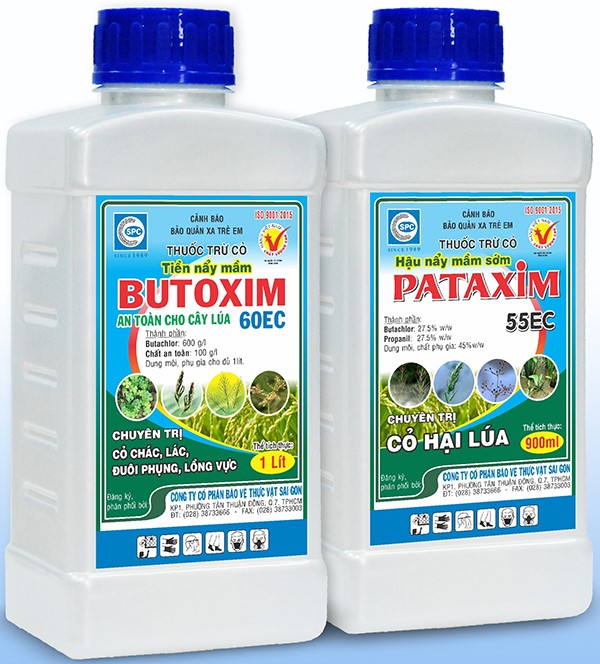|
USE OF PESTICIDE FOR THE AUTUMN-WINTER RICE FIELD
21/06/2023
USE OF PESTICIDE FOR THE AUTUMN-WINTER RICE FIELD 26/05/2022 In recent months, Saigon Plant Protection Joint Stock Company has received many feedback letters from fellow farmers in the Mekong River Delta stating that Cyperus difformis , Fimbristylis miliacea is difficult to remove, even though it has been sprayed. products, but this weed still exists in the field and asked the company to explain the reason as well as introduce to people what products can eliminate weeds in rice fields, especially Cyperus difformis , Fimbristylis miliacea etc. but still safe for rice. There are many types of weeds in rice fields, each type of weed has different characteristics in morphology, structure, growth and development. Due to the above difference, weeds are classified into 3 groups: Grass weeds, Sedge weeds and broadleaved weeds.Cyperus difformis , Fimbristylis miliacea belonging to the group of sedge weeds, solid stem, triangular angle, vertical tree form, narrow and short leaf blate, smooth leaf surface, often thrive in the wet fields, so the small weed stage is often covered by rice foliage or covered with water .
In the Autumn-Winter rice crop, it rains a lot, it is difficult to drain the water, the water level in the field is high, so it is difficult for spraying to contact the stems and leaves, especially Cyperus difformis , Fimbristylis miliacea ,at a small stage, just growing .As as result these weed species still exist and grow in clusters in the rice fields that have been sprayed with herbicides, so for this group of weeds, It is appropriate for people to use herbicides that have both foliar contact and root seeping properties. There are many herbicides on the market and are sold under many different trade names. However, in terms of effects, herbicides can be classified into two main groups: pre-emergence and post-emergence. The group of pre-emergence products, also known as germicides, are used when the weed seeds just crack, sprout or have the first leaves. In this group, we would like to introduce to you the herbicide Butoxim 60EC, this is a product of Saigon Plant Protection Joint Stock Company, research and production, which is very popular with farmers because highly effective in both technical and economic terms with the following outstanding features: - Butoxim 60EC penetrates into plants through the roots and through the stem, so it kills weeds at all three stages: the weed has not yet grown, the weed has just sprouted or has the first leaves. - Kills many common weeds in rice fields belonging to all three groups of weeds, such as: Leptochloa chinensis, Echinochloa sp , Cyperus difformis , Fimbristylis miliacea , Ludwigia octovalvis - Butoxim 60EC completely kills weeds while the rice germ is still growing and developing well. Because of the safener in the product, Butoxim 60EC is considered a highly selective herbicide that does not harm rice. - Spray after sowing from 1-3 days with dose: 1.2 liters of product to use for 1 hectare, ie mix 60ml of product in a 16-liter-water tank, spray 02 tanks for a field of 1000 m2. - After spraying 1-3 days, put water in the field, adjust the water level appropriately for the rice seeds that are sprouting leaves, do not let the field surface dry and crack after spraying. For the group of post-emergence herbicides, the product has an effect when the weed has grown leaves; In case of early use when the weed has 1-3 leaves, it is called early post-emergence, if used later when the weed has more than 03 leaves, it is called late post-emergence. In the group of herbicides in the early post- emergence stage, we would like to introduce Pataxim 55EC of Saigon Plant Protection Joint Stock Company. Pataxim 55EC is a mixed herbicide with 02 active ingredients Butachlor and Propanil in emulsifiable concentrate form, light brown color. - Butachlor has systemic properties, kills weeds at the pre-emergence stage, when the weed seeds have not yet grown and the newly-grown weed is still small. Butachlor penetrates into plants mainly through the sprouts and through the roots to the inside, inhibiting protein synthesis and stem growth. - Propanil has a contact effect, killing weeds in the post-emergence stage, when the weed has grown leaves, inhibiting photosynthesis, causing weeds to die. - Combining the above two active ingredients, the Pataxim 55EC product kills many common weeds in rice fields belonging to all 3 groups : Grass weeds , sedge weeds, and broadleaved weeds. - Pataxim 55EC is used for seeded and transplanted rice in the period from 4 to 12 days, respectively when the weeds is newly grown, the leaves are small (the weeds has 1-3 leaves). - The amount of product used is from 2 - 2.5 liters/Ha, mix 80 - 120 ml of product/ 16-liter-watertank, spray to cover the field from 2 - 2.5 tanks for a field of 1000 m2. Spray early, use low dose, spray late, use high dose according to instructions. - When spraying, the field needs to be dry but moist enough. After spraying 1-3 days, let water into the field, adjust the field water level in accordance with the growth stage of the rice plant. Note: - Do not spray when the temperature is below 180C and do not use the product on other plants that are sensitive to the product. Before spraying, people need to carefully read the instructions written on the product packaging to apply. - Recognizing the feedbacks of many rice farmers in the Mekong River Delta through the actual use of herbicides, said: Combining Pataxim 55EC with Butoxim 60EC will give very good weed control results on the fields with a lot of Leptochloa chinensis . Cyperus difformis , Fimbristylis miliacea
|
To prevent, in addition to plowing and burying weed seeds, collecting weed stalks and stumps left after tilling the land to burn, not letting weeds produce seeds in production fields, etc., the use of chemical products is still a measure. optimal because of its ability to thoroughly kill weeds, reduce labor and take advantage of more time than manual weeding.
Miner has the scientific name Phyllocnistis citrella Staint., family Phyllocnistidae, order Lepidoptera. The miner occurs in many countries in the tropics and subtropics. The main host of the miner is the citrus family - Rutaceae. In addition, the miner also attacks mangosteen and some other plants.
Adult is a small planthopper, with a body 2-3 mm long, the whole body is ash gray, slightly greenish, the wings are opaque with many small brown spots.Eggs are oval, 0.3 mm long, have a pointed end and are attached directly to the leaf surface, leaf axils.
Green bugs specialize in the fruit of citrus groups (oranges, tangerines, lemons, grapefruits, kumquats...), some people call them orange bugs, or orange suckers. Their scientific name is Rhynchocoris poseidon or Rhynchocoris humeralis.
In Vietnam, yellow leaf curl disease is very common on papaya trees, especially the disease is often severe in areas of high and continuous planting, areas with hot and arid climates. The disease has significantly reduced the yield and quality of papaya. Gardens that are infected early when the plants are young may not yield. However, up to now, many gardeners still do not know the cause and how to fix it.
Spider mites are common pests on citrus trees, especially in hot and dry climates that are suitable for spiders to grow and cause severe damage.The group of harmful spiders is usually very small in size, unlike the natural enemy spiders.
This group includes species that are generally very small in size, causing damage by sucking plant sap (on leaves, fruits, branches, stems).
There are many species of mealybugs present on the group of Oranges,Tangerines,Grapefruits and Lemons (Citrus), which can be divided into 2 groups:
+ Group of sticky mealybugs with common varieties such as Lepidosaphes, Aonidiella, Coccus and Saissetia.
+ Group of flower mealybugs with common genera and species such as Pseudococcus, Planococcus and Icerya purchasi.
Dry branches and berries disease often appear to be common damage on coffee gardens during the rainy season. The disease causes death of branchs, dry fruit, severely affects the canopy structure and coffee yield if not paid attention to prevention.
Pink disease commonly causes diseases on rubber plantations in the rainy season, especially on garden from 4-8 years old. This year, rubber has to go through a period of severe drought, weakening the tree, so now in tnshe rainy season it is easy to get infected. Therefore, it is necessary to pay attention to good management to avoid affecting the garden.
In recent years, the area of citrus has been expanded because it is a fruit tree with high economic efficiency. However, in order to sell at a high price, not only in quality but consumers also require the external beauty of the fruit, so pest management on citrus is a matter of great concern to farmers. The hot season is a favorable condition for thrips to develop and cause damage, affecting the commercial value of fruit.
- Headquarters
- SAIGON PLANT PROTECTION JOINT STOCK COMPANY
- RQ 1, Nguyen Van Quy St., Tan Thuan Ward, HCM City
- Tax code: 0300632232
- Tel: (028) 38 733 295 - 38 732 077
- Fax: (028) 38 733 003 - 38 733 391
- Website: www.spchcmc.vn - Email: info@spchcmc.vn
- SAIGON PLANT PROTECTION COMPANY
- SAIGON PLANT PROTECTION JOINT STOCK ENTERPRISE
- Lot C1-C3 Hiep Phuoc Industrial Park, Hiep Phuoc Commune, HCM City
- Tel: (028) 3873 4089 - Fax: (028) 3873 4086
- Affiliated Unit
-
- Quick Links
- Home
- About us
- Career Opportunities













